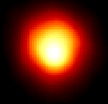
We will now consider stars with masses less than about twice the mass of the Sun. Once a star has used up its central supply of Hydrogen, the central core contracts and the hydrogen surrounding it heats up and creates a shell which increases its luminosity. The star also expands. |

The expansion causes the temperature at the surface to decrease and the star leaves the main sequence. It becomes a red giant, which can be found in the high-luminosity and low-temperature portion of the H-R diagram. In a main sequence star, if the core of the star becomes hotter for any reason, the core can expand slightly and the temperature will drop. However, in a degenerate core, raising the temperature does not increase the pressure, but it will speed nuclear reactions which will raise the temperature even further. After a while all helium in the central region, is used up and the core no longer produces energy. Now we have a core of carbon and oxygen surrounded by a shell where helium is still burning and the star moves back to the red giant domain. Stars with lower mass can't compress the carbon-oxygen core to initaiate another stage of nuclear burning and instead it leaves behind a White dwarf. |

Since no star completes it's evolution to a red giant quickly enough for us to observe the changes, this description of stellar evolution is based entirely on calculations of models. Fortunately, we can test the calculations of stellar models by observing a cluster of stars which all formed at the same time but with different masses. One main advantage of using clusters instead of individual stars is that they are at the same distance so that their luminosities can be directly compared. |
|
Last modified 9th August 1999 Sarah Amandusson www_astro@mssl.ucl.ac.uk |